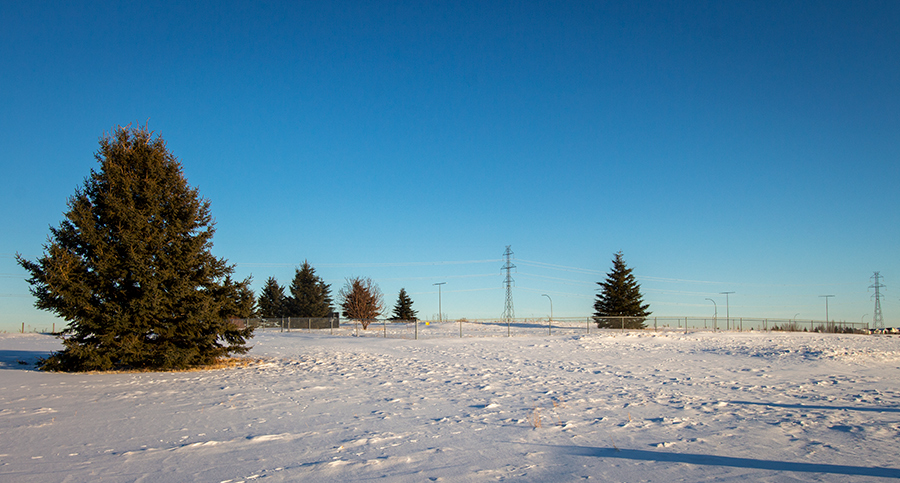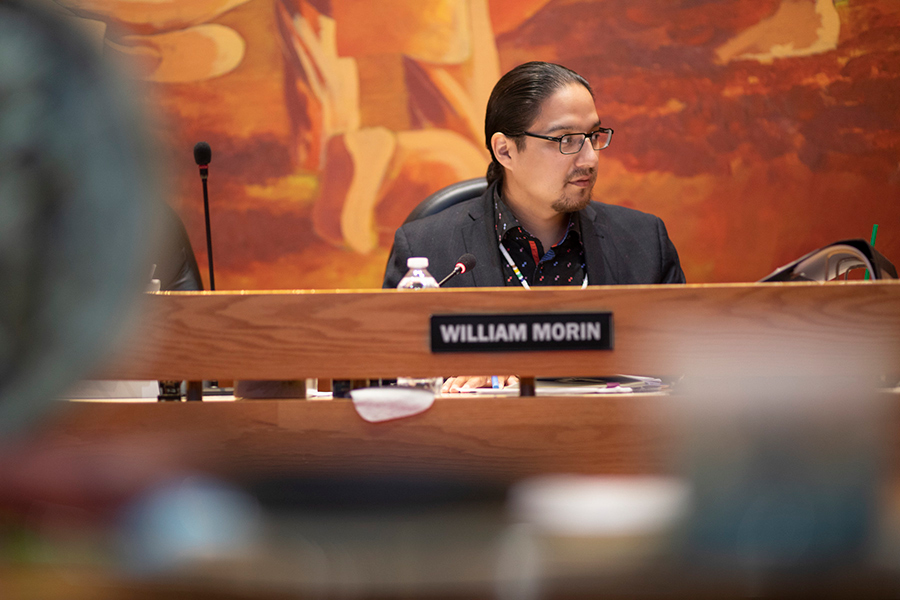Enoch Cree Nation chief sees real estate development as ‘reconcili-action’
Located between the hectic Anthony Henday Drive to the west and dark rowhouses to the east that define the edge of Edmonton’s Glastonbury neighbourhood, Billy Morin’s vision for the future can be easy to overlook. It’s a plot of land the size of two or three residential lots, marked by a short chain-link fence and a few coniferous trees.
But Morin (Civil Engineering Technology ’11, Bachelor of Technology in Technology Management ’13), third-term chief of Enoch Cree Nation, knows how important that land really is. It’s the gravesite of the first chief in his nation’s modern history, as well as the final resting place of other First Nations ancestors.
It’s also important, however, for the fact that it does not belong to Enoch Cree Nation, the edge of which lies roughly two kilometres west. Currently, this is city land. To Morin, that’s an opportunity to establish it as an urban reserve – a potential first for a major Alberta city.
An urban reserve is a plot of land within city limits that is owned by a First Nation and can achieve reserve status from the federal government. There are more than 120 of these across Canada; the first was created in Saskatoon in 1988 by Muskeg Lake Cree Nation.

For Morin, reclaiming the gravesite as an urban reserve is a step toward establishing other local urban reserves for commercial and residential development in the heart of Edmonton, home to Canada’s second-largest population of First Nations peoples living off reserve.
As the process began, Morin spoke with techlifetoday about the true value of real estate, and what it may mean to Enoch Cree Nation in rectifying the past and planning for the future.
Techlifetoday: When did it occur to you to do this?
Chief Billy Morin: In 2017, we signed the City of Edmonton memorandum of understanding with Enoch Cree Nation [to strengthen our relationship]. The mayor [Don Iveson] floated this idea of an urban reserve.
What appealed to you about the idea?
When a person comes to the city from the reserve, it is sometimes like coming to a foreign country or a different environment. They don't have access to family, to friends, to ceremony, to culture. There's something different about saying this piece of land is a reserve that we can call our own as opposed to a city neighbourhood, which is just another street and address.
“There's something different about saying this piece of land is a reserve that we can call our own.”
How do urban reserves work in relation to a city in which they’re located?
You can acquire additions to the reserve [that have] federal status … under the Indian Act and under treaty.
[An urban reserve] does have to follow the basic principles of responsible development within the city. It's just that the First Nation can have final say and jurisdiction over some of the operations and businesses that open up there. We couldn't buy a piece of land next to the West Edmonton Mall and build an industrial park.
What could one look like?
Our first one I propose is actually the gravesite that has Enoch's first chief buried in it. It's in the Glastonbury neighbourhood [in west Edmonton]. And quite frankly, it'll just stay a grave site. It'll be a combination of negotiations with the City and the province to get it back.
“It's going to set the precedent for every other urban reserve.”
We’re doing that strategically because we want to create one. The hardest thing about getting going is getting one done. It is a great act of reconciliation to get the gravesite back. It's going to set the precedent for every other urban reserve.
There's the first one we want to get done, which is small and strategic, but really meaningful. And then there's a whole bunch of other stuff that we can do in the long term.
Such as?
A big hairy goal would be acquiring land in the Quarters [the neighbourhood just east of downtown Edmonton], which has had a vision for development for a long time [but] hasn't taken off.
It can be established as an urban reserve, which would attract new investment for a specific, Indigenous kind of development: housing, social supports, maybe some new government and servicing arms, new servicing options for multiple First Nations and treaty organizations, right downtown.

Given the need for development in that part of the city, this kind of relationship seems like it would be mutually beneficial.
I realize that there would be a lot of Edmontonians who would say, “Are they going to pay their fair share of taxes? This can't be a free ride.” Nobody's proposing that with a development like this. We have to have a servicing agreement that pays for water, sewer, all those basic services that the city gives. They're not free.
In return, Indigenous peoples on reserves have different access to capital through the First Nations Finance Authority at lower rates that [developers] wouldn't have on just any city plot with municipal status. First Nations have access to money that can really drive development.
Or, maybe a reserve such as Enoch or some of the reserves from up north around Treaty 8 acquire a piece of land by NAIT and build residential for their students. If they had a place they can call home that has some kokums and some mushums – which are grandmother and grandfather – they can feel a little bit more comfortable.
You mentioned reconciliation. How might urban reserves advance that?
I think the tagline now is “reconcili-action.” Reconciliation is probably a never-ending journey but we have to have some milestones and some measurement.
“Reconciliation is probably a never-ending journey but we have to have some milestones and some measurement.”
Several years have passed since this first came up. Why is now the right time?
The dialogue just kind of never took off. Enoch is a small First Nation, but we have a lot going on with economic development, and the city is a big bureaucracy. What happened recently was Coun. Sarah Hamilton – who I have to give a lot of credit to; she's actually my councillor since I live in the city – she said, “There's gotta be some way that me and you can work together, Billy.”
So we had this conversation and she said, “What's stopping me from putting in a motion and putting something into action?” I'm really thankful to Coun. Hamilton who picked up the slack and made this “reconcili-action” happen.
What is your timeline for that first one?
I would like to see this happen within 365 days.
How would urban reserves advance some of the goals that originally brought you to your job as chief?
I want to be somebody who helped build bridges – somebody who really put thoughts and words into action. What better actions are there than something that's never been done before in the City of Edmonton, or in the capital region, or Treaty 6, that's for all Albertans and Edmontonians and First Nations?
That's really the true treaty relationship, right? Working together.
Originally published Feb. 23, 2021
How Enoch’s first chief came to be buried in Edmonton
When the first leader in the modern history of Enoch First Nation, Chief Enoch Lapotac, died in 1861, he was buried in a location that was then part of the reserve. In 1908, Minister of the Interior and Superintendent General of Indian Affairs Frank Oliver found a way to transfer this land to settlers. (Residents of Edmonton’s Oliver neighbourhood are currently working to change its name in light of the minister’s often discriminatory policies.)
The legitimacy of the nation’s surrender of these 2,500 hectares, which allegedly involved intimidation and a lack of consultation, has been questioned ever since. In 2004, the issue was settled financially with a successful $54-million federal land claim by Enoch First Nation. The land, now mostly residential subdivisions, won’t be returned. But it will be meaningful to current Enoch’s current chief, Billy Morin, if the gravesite is.
“It’s a little step back in time to right the wrong,” he says. “There are still some open wounds there.”
Originally published Feb. 23, 2021